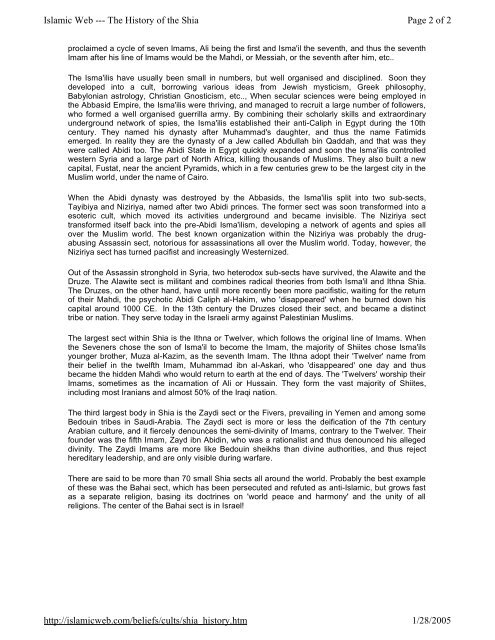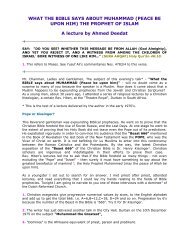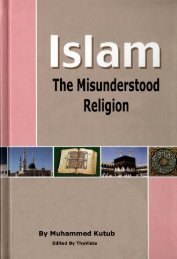Collection Of Articles (Refuting Shia) - Enjoy Islam
Collection Of Articles (Refuting Shia) - Enjoy Islam
Collection Of Articles (Refuting Shia) - Enjoy Islam
Create successful ePaper yourself
Turn your PDF publications into a flip-book with our unique Google optimized e-Paper software.
<strong>Islam</strong>ic Web --- The History of the <strong>Shia</strong><br />
Page 2 of 2<br />
proclaimed a cycle of seven Imams, Ali being the first and Isma'il the seventh, and thus the seventh<br />
Imam after his line of Imams would be the Mahdi, or Messiah, or the seventh after him, etc..<br />
The Isma'ilis have usually been small in numbers, but well organised and disciplined. Soon they<br />
developed into a cult, borrowing various ideas from Jewish mysticism, Greek philosophy,<br />
Babylonian astrology, Christian Gnosticism, etc.., When secular sciences were being employed in<br />
the Abbasid Empire, the Isma'ilis were thriving, and managed to recruit a large number of followers,<br />
who formed a well organised guerrilla army. By combining their scholarly skills and extraordinary<br />
underground network of spies, the Isma'ilis established their anti-Caliph in Egypt during the 10th<br />
century. They named his dynasty after Muhammad's daughter, and thus the name Fatimids<br />
emerged. In reality they are the dynasty of a Jew called Abdullah bin Qaddah, and that was they<br />
were called Abidi too. The Abidi State in Egypt quickly expanded and soon the Isma'ilis controlled<br />
western Syria and a large part of North Africa, killing thousands of Muslims. They also built a new<br />
capital, Fustat, near the ancient Pyramids, which in a few centuries grew to be the largest city in the<br />
Muslim world, under the name of Cairo.<br />
When the Abidi dynasty was destroyed by the Abbasids, the Isma'ilis split into two sub-sects,<br />
Tayibiya and Niziriya, named after two Abidi princes. The former sect was soon transformed into a<br />
esoteric cult, which moved its activities underground and became invisible. The Niziriya sect<br />
transformed itself back into the pre-Abidi Isma'ilism, developing a network of agents and spies all<br />
over the Muslim world. The best known organization within the Niziriya was probably the drugabusing<br />
Assassin sect, notorious for assassinations all over the Muslim world. Today, however, the<br />
Niziriya sect has turned pacifist and increasingly Westernized.<br />
Out of the Assassin stronghold in Syria, two heterodox sub-sects have survived, the Alawite and the<br />
Druze. The Alawite sect is militant and combines radical theories from both Isma'il and Ithna <strong>Shia</strong>.<br />
The Druzes, on the other hand, have until more recently been more pacifistic, waiting for the return<br />
of their Mahdi, the psychotic Abidi Caliph al-Hakim, who 'disappeared' when he burned down his<br />
capital around 1000 CE. In the 13th century the Druzes closed their sect, and became a distinct<br />
tribe or nation. They serve today in the Israeli army against Palestinian Muslims.<br />
The largest sect within <strong>Shia</strong> is the Ithna or Twelver, which follows the original line of Imams. When<br />
the Seveners chose the son of Isma'il to become the Imam, the majority of Shiites chose Isma'ils<br />
younger brother, Muza al-Kazim, as the seventh Imam. The Ithna adopt their 'Twelver' name from<br />
their belief in the twelfth Imam, Muhammad ibn al-Askari, who 'disappeared' one day and thus<br />
became the hidden Mahdi who would return to earth at the end of days. The 'Twelvers' worship their<br />
Imams, sometimes as the incarnation of Ali or Hussain. They form the vast majority of Shiites,<br />
including most Iranians and almost 50% of the Iraqi nation.<br />
The third largest body in <strong>Shia</strong> is the Zaydi sect or the Fivers, prevailing in Yemen and among some<br />
Bedouin tribes in Saudi-Arabia. The Zaydi sect is more or less the deification of the 7th century<br />
Arabian culture, and it fiercely denounces the semi-divinity of Imams, contrary to the Twelver. Their<br />
founder was the fifth Imam, Zayd ibn Abidin, who was a rationalist and thus denounced his alleged<br />
divinity. The Zaydi Imams are more like Bedouin sheikhs than divine authorities, and thus reject<br />
hereditary leadership, and are only visible during warfare.<br />
There are said to be more than 70 small <strong>Shia</strong> sects all around the world. Probably the best example<br />
of these was the Bahai sect, which has been persecuted and refuted as anti-<strong>Islam</strong>ic, but grows fast<br />
as a separate religion, basing its doctrines on 'world peace and harmony' and the unity of all<br />
religions. The center of the Bahai sect is in Israel!<br />
http://islamicweb.com/beliefs/cults/shia_history.htm<br />
1/28/2005
















